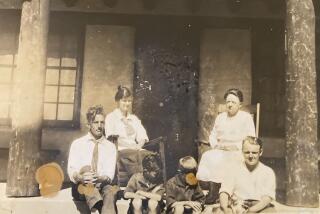Joys of Car Travel: Surprises Around the Corner
- Share via
This started out be a series of vignettes about driving across the United States. Sitting in a motel in northern Florida, I have a notebook half full of them already. But one stop during the first week of this odyssey turned out to be so full of meaning to me that it drove the rest of the vignettes to another column.
Chief among the great joys of auto travel are the surprises you come on quite suddenly--places you knew of vaguely or not at all that turn out to be full of both pleasure and insight. That happened to me twice on my second day in Texas.
I drove for 970 miles in the state of Texas--from El Paso to the Louisiana border with a few small detours. It’s a state I’ve never particularly liked since spending a year there during World War II. I had been driving for two days through the mesquite and desert and canyon land of the American Southwest, and Texas started out the same way.
Then, almost magically, the terrain in central Texas changed to verdant green hills. I had wanted to visit the University of Texas in Austin and noticed that the home of the late President Lyndon Johnson was on the route, so I detoured to a town called Fredericksburg, just a few miles from the LBJ ranch.
I got in there long after dark, found a motel and went to bed. The name seemed odd to me in a state where the towns tend to be named for Texas patriots or Spanish antecedents, but not until morning did I discover that I had blundered into a town settled by German immigrants shortly after the American Civil War. The architecture was early 19th-Century German, and so was the food.
Wandering Fredericksburg after breakfast, I made another discovery. It was also the home of the late Adm. Chester W. Nimitz, who commanded the U.S. Navy in the Pacific during World War II. And in the center of town in an ancient former hotel was housed the finest naval World War II museum I’ve ever seen.
When I told the park ranger at the door I had once worked for Adm. Nimitz, she gave me back my $2 entrance fee and waved me in. For an hour, I wallowed in graphics of Pacific islands I’d visited courtesy of the Navy. Then I turned a corner and saw mounted in a glass case--rather like suits of armor and Revolutionary and Civil War uniforms I’ve seen similarly displayed--an exhibit labeled: “The American naval aviator’s flight gear in World War II.”
The jacket was a carbon copy of the one I’d dusted off after years in my garage and given to my oldest daughter--who requested it devoutly--last Christmas. The helmet and goggles, which looked almost antediluvian on the model, I have in a drawer somewhere at home.
It’s a hell of a shock for a man with a lot of spring still in his step to see himself in a museum. A few minutes later, still brooding, I came on the plane I used to fly displayed on the grounds surrounding the museum. Not a model but the real thing: a Douglas Dauntless dive bomber. It was enormous, and I stood there for 15 minutes looking at it and trying to picture myself in it. I couldn’t even remember how I got up to the cockpit.
A middle-aged man with a pronounced belly and a cowboy hat, accompanied by a slight woman in a gingham dress, stood beside me for a moment, and I heard the man say to his companion, “I didn’t know carrier planes were that big in World War II.”
“I used to fly that plane,” I told them.
They both looked at me uneasily, smiled and moved on. And I went back to my car struggling with the concept that I am now a museum piece.
I was still thinking about that when I pulled into the Park Service buildings at the LBJ ranch. I studied the pictures displayed there of the people President Johnson had entertained at his ranch--potentates and heads of state summoned to eat barbecue in rural Texas by the chief executive of a country they needed, feared or wanted something from. It came clear to me in his own environment how well Johnson understood and used power. He grew up just 15 miles away in a town named for his daddy, who was also a politician, and surrounded by family that ran this little piece of Texas.
I walked down to the Pedernales River and looked across to the rambling, white, frame house that is still home for Lady Bird Johnson. And for the first time, I understood why LBJ kept pouring men into Vietnam in a lost cause that sundered the nation. In this Texas town where he grew up, men kicked butt when they were challenged. He’d done it all his life as he moved to the highest office in the land. And when some diminutive foreigners in a far-off corner of the world challenged not only his country but LBJ, himself, he did what he had always done so successfully before: applied muscle. Only this time it didn’t work. They didn’t play by his rules.
Directly across from his house, on the far bank of the Pedernales, is a statue of Johnson standing, one hand in pocket, the other hand outstretched with finger pointing in a typical, truculent LBJ posture. It is as right and appropriate as the fact that Johnson is buried under a simple stone in a family plot near his home.
I went on to Austin to go through the Johnson presidential library there. I think the libraries our ex-Presidents have left as monuments say much about them as men, and so far I’ve visited four: Eisenhower, Truman, Hoover (all within a day’s drive of each other) and Franklin Roosevelt. Only Roosevelt and Truman allowed their warts to show in public displays. Not unexpectedly, Johnson didn’t. To say that the exhibits in his library accentuate the positive--especially when dealing with the Vietnam years--is to put it mildly.
And so I pushed on. A day’s drive to the east on Interstate 10, the spot in front of the Louisiana state Capitol in Baton Rouge where Huey Long was assassinated has been enshrined. But that’s another day--and another piece of Americana for the highway traveler to ponder.
More to Read
Sign up for The Wild
We’ll help you find the best places to hike, bike and run, as well as the perfect silent spots for meditation and yoga.
You may occasionally receive promotional content from the Los Angeles Times.






